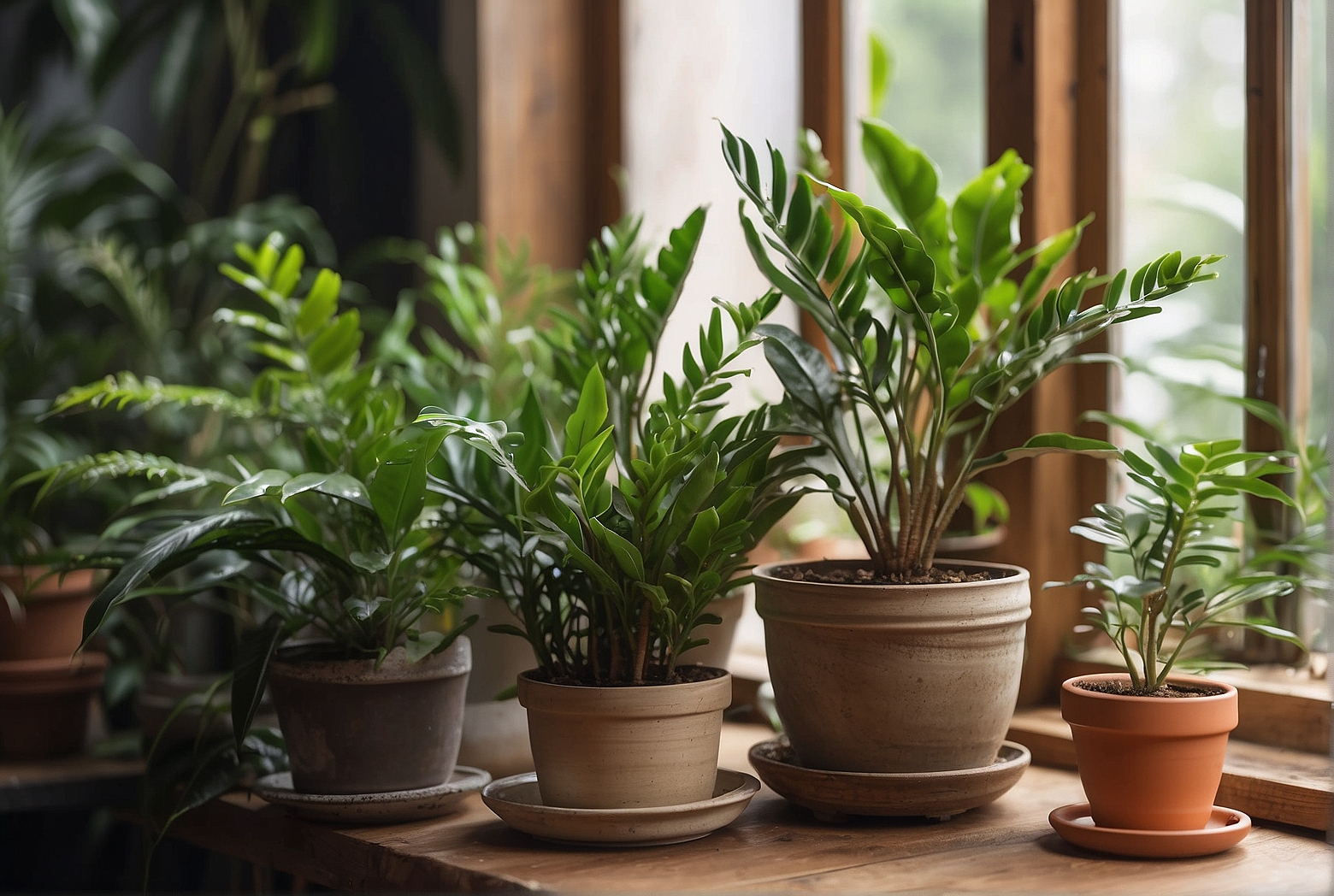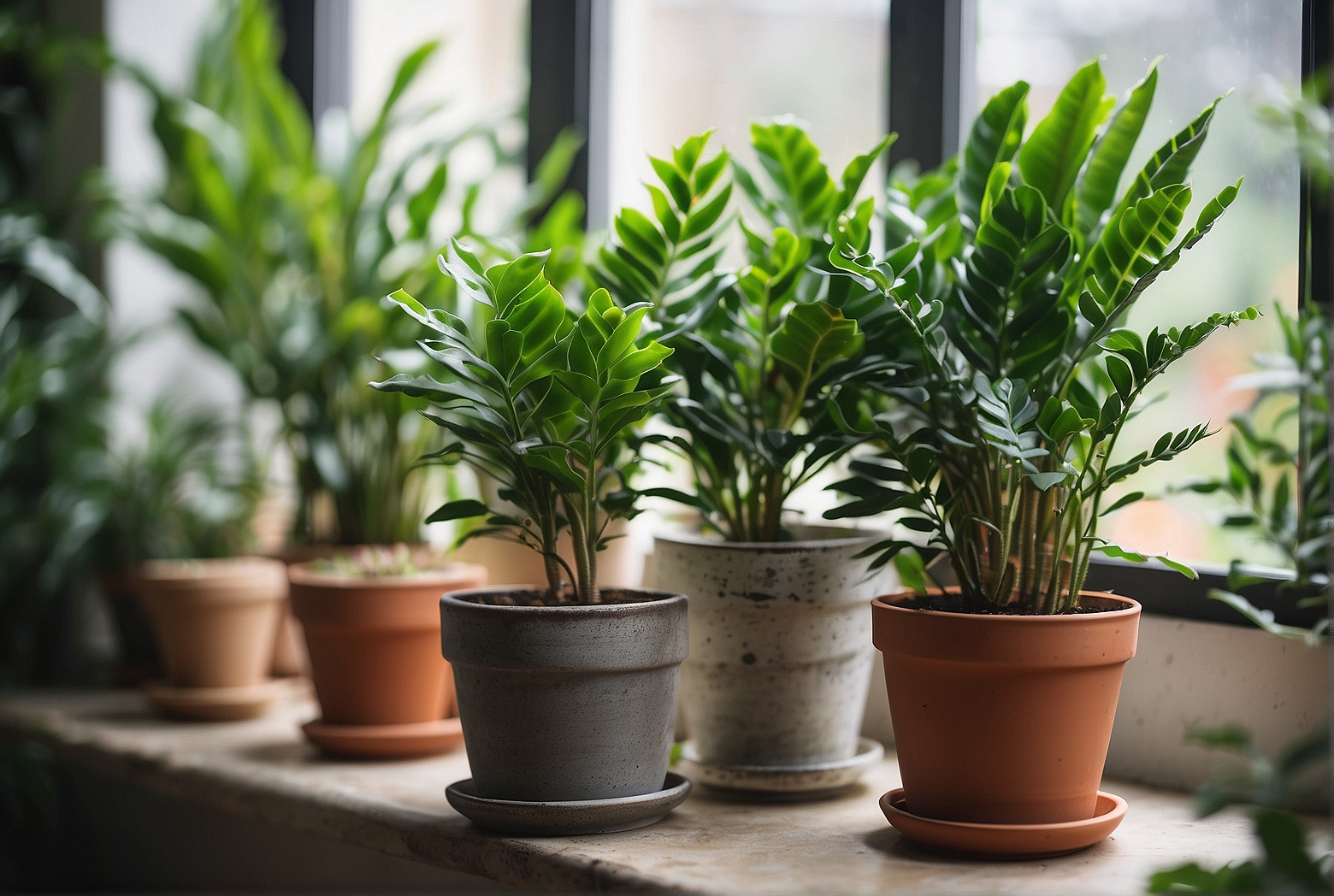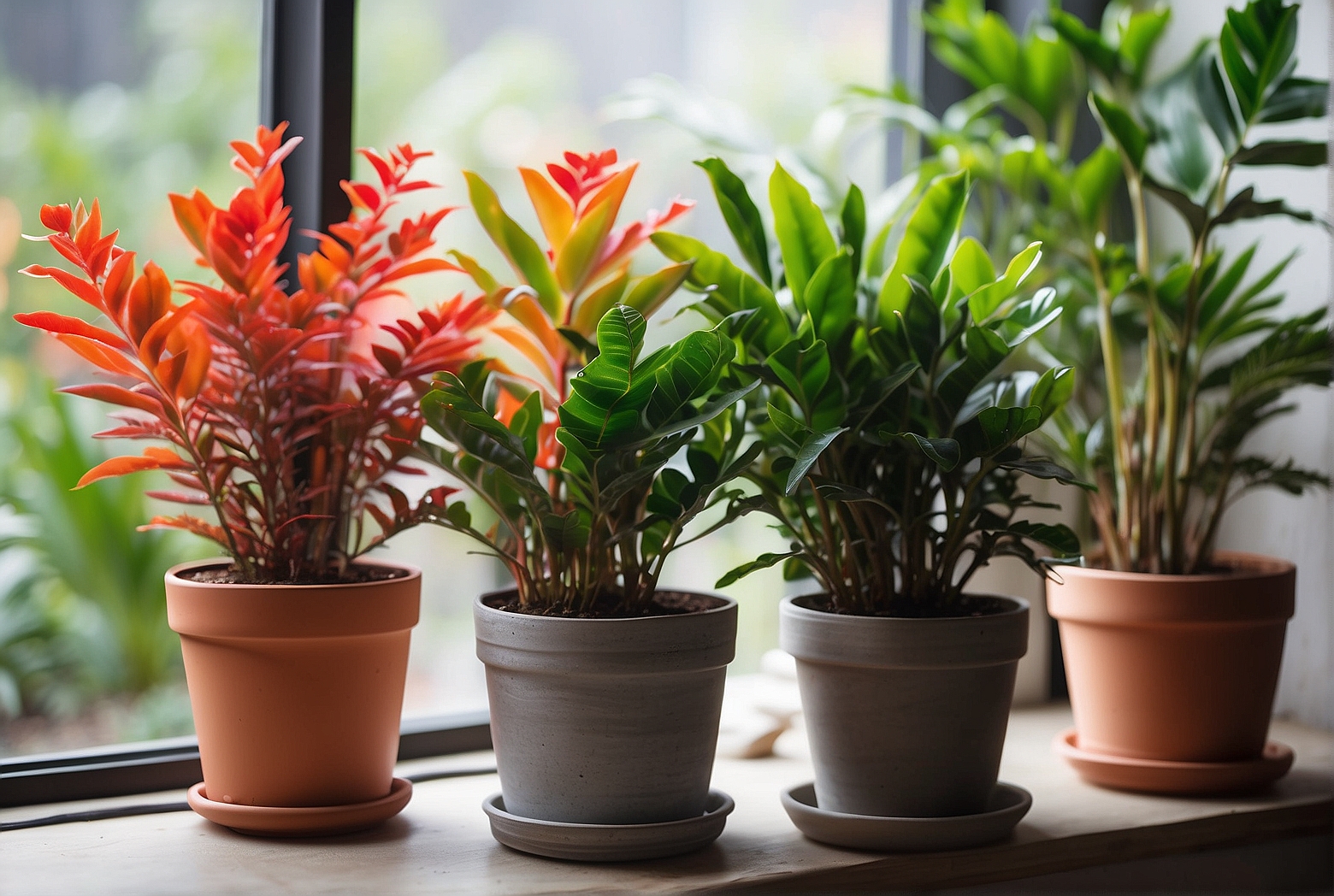Last Updated on April 10, 2024 by Tony Manhart
If you’re looking for a low-maintenance and aesthetically pleasing plant to brighten up your indoor space, look no further than the ZZ plant. With its glossy foliage and ability to thrive in low light conditions, the ZZ plant has become a popular choice among plant enthusiasts. In this ultimate guide, you will discover everything you need to know about caring for ZZ plants indoors, from proper watering techniques to ideal lighting conditions and the best fertilizer to use. Get ready to transform your space into a lush and green oasis with this easy-to-follow guide.
Choosing the Right Location
Amount of Light
When it comes to choosing the right location for your ZZ plant, the amount of light it receives is crucial. ZZ plants are known to thrive in low-light conditions, making them perfect for indoor environments. However, they can also tolerate bright, indirect light. Place your ZZ plant near a window with sheer curtains or in a spot that receives bright, indirect light throughout the day.
Temperature
ZZ plants are native to tropical regions, so they prefer warm temperatures between 60-75°F (15-24°C). Avoid placing your ZZ plant in areas with extreme temperatures or drafts, as this can lead to stress and affect the plant’s overall health. It’s important to provide a consistent temperature for your ZZ plant to ensure optimal growth and vitality.
Humidity
While ZZ plants are generally tolerant of low humidity levels, they can benefit from increased humidity. If you live in a dry climate or have a particularly arid indoor environment, consider using a humidifier to increase the moisture levels around your ZZ plant. Another option is to place a tray of water near the plant or group it with other indoor plants to create a microclimate with slightly higher humidity.

Watering and Drainage
Watering Frequency
ZZ plants have a unique ability to store water in their rhizomes, making them drought-tolerant plants. This means they can withstand periods of neglect and are great for forgetful plant owners. Water your ZZ plant only when the top inch of soil feels dry to the touch. Overwatering can lead to root rot and other moisture-related issues, so it’s important to strike a balance and avoid excessive watering.
Checking Soil Moisture
To determine if your ZZ plant needs watering, check the moisture level of the soil. Insert your finger about an inch deep into the soil, and if it feels dry, it’s time to water. If it still feels moist, wait a few more days and check again. Remember, it’s better to underwater than overwater your ZZ plant, as it can tolerate periods of drought.
Drainage
While ZZ plants don’t like to sit in waterlogged soil, they do require proper drainage. Choose a well-draining potting mix and ensure that your plant’s container has drainage holes. This will prevent excess water from accumulating in the soil and causing root rot. Additionally, if you accidentally overwater your ZZ plant, ensure that the excess water can freely drain out of the pot.
Fertilizing
Frequency of Fertilization
ZZ plants are relatively low-maintenance when it comes to fertilizing. They don’t require frequent or heavy feeding. Fertilize your ZZ plant once every two to three months during the growing season, which typically spans from spring to early fall. This will provide the plant with the necessary nutrients without overwhelming it.

Choosing the Right Fertilizer
When selecting a fertilizer for your ZZ plant, choose a balanced, water-soluble fertilizer with a nitrogen-phosphorus-potassium (N-P-K) ratio of 10-10-10 or 20-20-20. These ratios ensure a good balance of essential nutrients for healthy growth. Alternatively, you can opt for a slow-release fertilizer, which gradually releases nutrients over time.
Application Method
When applying fertilizer to your ZZ plant, dilute it according to the package instructions and water the plant with the fertilizer solution. Be cautious not to overfertilize, as this can lead to fertilizer burn and other nutrient-related issues. It’s better to err on the side of caution and slightly under-fertilize your ZZ plant, as it can tolerate low nutrient levels.
Pruning and Grooming
Removing Yellowing Leaves
Yellowing leaves on your ZZ plant can indicate various issues, such as overwatering, underwatering, or nutrient deficiencies. To maintain the plant’s overall health and appearance, it’s important to remove these yellowing leaves promptly. Use clean, sharp scissors or pruning shears to trim off the affected leaves at their base. This will not only improve the plant’s aesthetic appeal but also prevent any potential disease or pest issues.
Trimming Overgrown Branches
If your ZZ plant becomes overgrown or develops long, straggly branches, pruning can help maintain its shape and encourage bushier growth. Use clean, sharp tools to trim the overgrown branches, making sure to cut just above a leaf node. This will stimulate the development of new branches and promote a fuller, more compact appearance. However, avoid excessive pruning, as ZZ plants can be slow to recover from heavy pruning.
Grooming for Appearance
Grooming your ZZ plant regularly can help keep it looking tidy and well-maintained. Dust the leaves gently with a soft cloth or use a mild, diluted soapy water solution to clean the foliage. This will remove dust and debris, allowing the plant to photosynthesize more efficiently. Additionally, you can gently rotate your ZZ plant every few weeks to ensure even growth and prevent it from leaning towards the light source.
Repotting and Division
When to Repot
ZZ plants are relatively slow-growing and can thrive in slightly crowded conditions. However, if your ZZ plant becomes root-bound or starts outgrowing its current pot, it’s time to repot. Signs of a root-bound ZZ plant include roots growing out of the drainage holes and a lack of new growth despite appropriate care. Ideally, repot your ZZ plant in spring before the start of its growing season.
Choosing the Right Pot
Selecting the right pot for your ZZ plant is essential for its overall health and growth. Choose a pot that is one size larger than the current one, providing room for the plant’s roots to spread. Ensure that the new pot has drainage holes to allow excess water to escape. Additionally, opt for a pot made of porous material, such as terra cotta, as it helps regulate moisture levels and prevents the soil from becoming too waterlogged.
Division Process
If your ZZ plant has grown into a clump with multiple rhizomes, division can be a beneficial propagation method and a way to refresh the plant. To divide your ZZ plant, gently remove it from its current pot and carefully separate the rhizomes. Each divided section should have healthy roots attached. Plant the divisions in separate pots with fresh potting mix, water thoroughly, and continue caring for them as usual.
Pest Control
Identifying Common Pests
ZZ plants are generally resistant to pests, but they can occasionally get infested. Some common pests that may affect ZZ plants include mealybugs, spider mites, and scale insects. Keep an eye out for small, crawling insects, cottony masses, or sticky residue on the leaves. Early detection and identification are crucial in preventing pest infestations from spreading and damaging your plant.
Natural Pest Control Methods
If you notice signs of pests on your ZZ plant, there are several natural methods you can use to control the infestation. One option is to wipe the leaves gently with a cloth soaked in a mild soap and water solution. This can help remove pests and their eggs. Additionally, you can use a spray bottle filled with a mixture of water and neem oil to treat your plant. Neem oil acts as a natural insecticide and can help control the pest population.
Chemical Pest Control
In severe cases of pest infestation, when natural methods aren’t effective, chemical pest control may be necessary. However, it’s important to exercise caution when using chemical solutions, as they can be harmful to both the pests and the environment. Read and follow the instructions on the pesticide carefully, and isolate the affected ZZ plant from other plants to minimize the risk of spreading the chemicals. Use chemical pest control as a last resort and consider seeking professional advice if needed.
ZZ Plant Propagation
Stem Cuttings
Propagation through stem cuttings is a simple and reliable method to grow new ZZ plants. Choose a healthy stem with several leaves and make a clean cut just below a leaf node. Remove the lower leaves of the cutting to expose the node and encourage root development. Place the cutting in water or a well-draining potting mix, keeping it consistently moist. After a few weeks, you should start noticing roots forming, indicating successful propagation.
Leaf Cuttings
Another propagation method for ZZ plants is through leaf cuttings. Select a healthy leaf and cut it into several sections, each with a small portion of the leaf base attached. Plant the leaf sections about an inch deep into a well-draining potting mix and keep them slightly moist. With time and proper care, each leaf section will develop roots and eventually grow into a new ZZ plant.
Air Layering
Air layering is a more advanced propagation technique but can be highly effective for ZZ plants. Select a healthy, mature stem and make a small incision or remove a small section of the outer bark. Apply a rooting hormone to the exposed area and wrap it with damp sphagnum moss. Cover the moss with plastic wrap to create a moist environment and secure it in place. Over time, roots will grow from the incision, and you can cut the stem below the rooted section and pot it as a new plant.
Common Issues and Troubleshooting
Yellowing Leaves
Yellowing leaves on a ZZ plant can be indicative of various underlying issues. Overwatering, underwatering, exposure to direct sunlight, or nutrient deficiencies can all cause the leaves to turn yellow. Assess your watering routine, lighting conditions, and fertilization schedule to ensure you’re providing the optimal care for your ZZ plant. Adjusting these factors and addressing any nutrient deficiencies should help resolve the yellowing leaf issue.
Wilting Plant
A wilting ZZ plant is typically a sign of underwatering. If the plant’s soil is dry and the leaves appear droopy or limp, it’s time to water your ZZ plant. Ensure that you thoroughly water the plant, allowing excess water to drain freely. If the wilting persists despite proper watering, check for root rot, which can lead to wilting due to damaged roots. In such cases, you may need to repot the plant and remove any affected roots.
Stunted Growth
Stunted growth in ZZ plants can occur due to a variety of reasons. Lack of proper light, inadequate watering, or nutrient deficiencies are common factors that can hinder growth. Assess your ZZ plant’s environment and care routine to identify any potential issues. Adjust the lighting, watering, and fertilizing as necessary to provide optimal conditions for your plant’s growth. Over time, your ZZ plant should recover and resume normal growth.
Decorative Tips
Choosing Suitable Pots
Choosing the right pots for your ZZ plants can enhance their overall aesthetic appeal. Opt for pots that complement the style of your home or the surrounding decor. Consider using pots made of materials like ceramic, terracotta, or decorative planters to add a touch of sophistication. Additionally, selecting pots with drainage holes is essential to ensure proper water flow and prevent waterlogging.
Enhancing the Visual Appeal
To enhance the visual appeal of your ZZ plant, consider incorporating decorative elements. You can place small pebbles or decorative rocks on top of the soil layer to create an attractive, finished look. Additionally, using plant stands or placing your ZZ plant on shelves at different heights adds dimension to your indoor space. Experimenting with different arrangements and combinations can help create a visually appealing display.
Complementary Plant Pairings
Pairing your ZZ plant with other indoor plants can create a beautiful and harmonious display. Consider complementary plant pairings based on their size, texture, and color. Plants with contrasting foliage, such as pothos or snake plants, can create an interesting visual contrast. Additionally, combining plants with different growth habits, such as trailing plants or upright ones, can add depth and variety to your indoor garden.
Benefits of ZZ Plants
Improving Air Quality
One of the significant benefits of ZZ plants is their ability to purify indoor air. They can effectively remove toxins like formaldehyde, benzene, and xylene, making them excellent natural air filters. This makes ZZ plants a valuable addition to any indoor space, especially in areas with poor air quality or where chemical pollutants may be present.
Low Maintenance Requirement
ZZ plants are well-known for their low maintenance requirements, making them perfect for busy individuals or those who may not have a green thumb. They can tolerate a wide range of lighting conditions, irregular watering, and periods of neglect. ZZ plants can thrive in various indoor environments with minimal care, which makes them an excellent choice for beginners and experienced plant lovers alike.
Well-suited for Indoor Environments
ZZ plants are native to tropical regions with low light levels, which makes them perfectly suited for indoor environments. Their ability to thrive in low-light conditions and tolerate dry air makes them ideal for offices, apartments, and other spaces with limited natural light. Additionally, their compact size and slow growth rate allow them to fit well in smaller spaces, such as shelves, desks, or coffee tables.
In a nutshell, taking care of your ZZ plant indoors involves providing the right amount of light, maintaining proper temperature and humidity levels, watering and fertilizing appropriately, pruning and grooming for appearance, repotting when necessary, implementing effective pest control methods, propagating through various methods, troubleshooting common issues, and adding decorative touches to enhance the overall visual appeal. ZZ plants offer several benefits, including air purification, low maintenance requirements, and suitability for indoor environments. With these comprehensive care instructions, your ZZ plant is sure to thrive and bring beauty to your indoor space for years to come.
Tony Manhart is a passionate gardener who has been tending to gardens for over 20 years. He takes pride in creating beautiful outdoor spaces with plants, trees, and shrubs that can thrive in any environment. He loves to share his knowledge with others and has taught classes on gardening basics and advanced techniques. He is committed to sustainability, using natural and organic methods to create and maintain gardens. He also works with local organizations to create green spaces for communities. When he’s not gardening, Tony enjoys hiking, reading, and spending time with his family.


